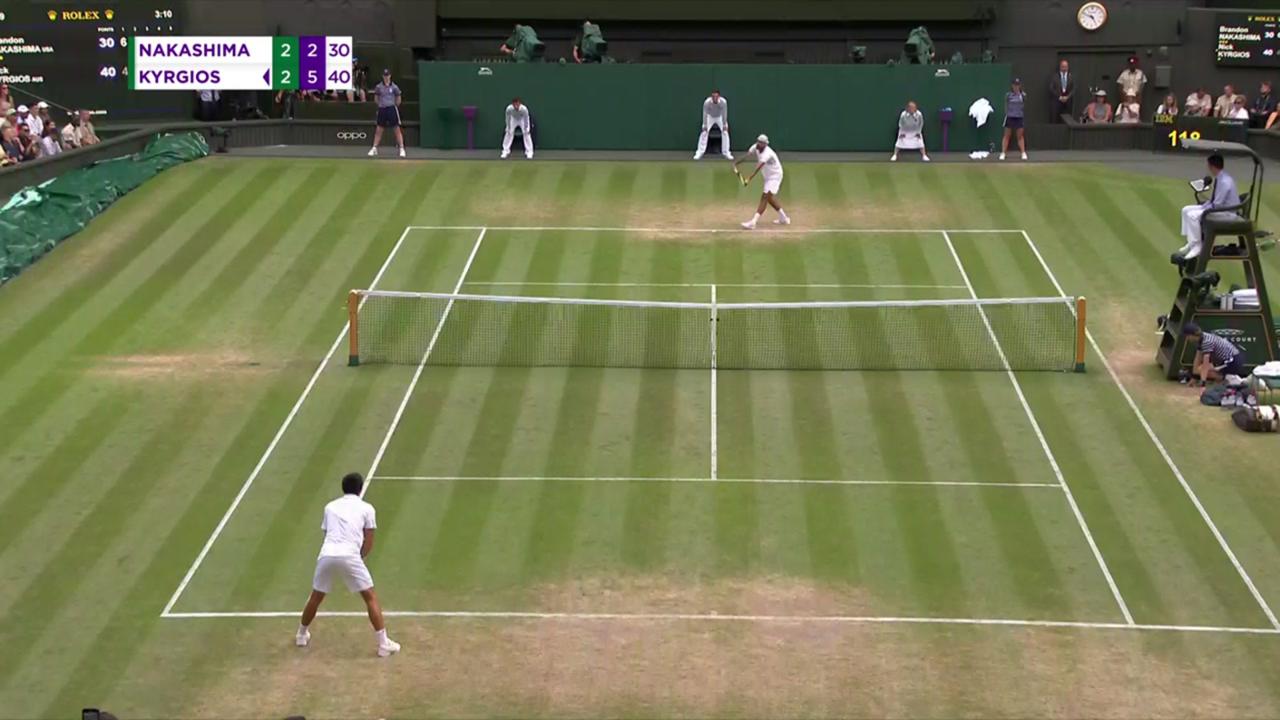An underarm serve, a forehand through the legs, a reversed baseball cap and the talent to turn any opponent inside out.
Centre Court saw most of the Nick Kyrgios repertoire, including the 130mph serves, the killer forehands and the delicate drop-shots.
What the crowd didn’t get – on the afternoon the Australian won a five-setter against American Brandon Nakashima to reach the quarter-finals for the first time in eight years – was anything approaching the drama, the attitude and the verbal sparring of his Saturday night clash with Stefanos Tsitsipas.
While there was a little light bickering with the umpire, and for some reason Kyrgios’ hat started to turn green as the match continued, threatening the all-white clothing rule, that was about as controversial as it got during his 4-6, 6-4, 7-6(2), 3-6, 6-2 victory.
In the opening stages, and also for a long while after, there was a Kyrgios that many inside Centre Court would have neither expected nor wanted: a subdued version of tennis’ most confrontational character. The issue was physical rather than mental, and certainly not a monarchist’s deference when playing in front of the Royal Box on what was his first Centre Court appearance of the Fortnight.
For all the pre-match discussions in the tennis parlour about what is going on in Kyrgios’ head, and also about his acid tongue, conversation around Centre Court soon focused on his right shoulder. He was wincing, hurting, clutching and holding that shoulder between points and also seen mouthing “can’t hit my forehand” in the direction of his box in the second set.
But with what looked like painkillers and a few massages from the physiotherapist, Kyrgios kept it all together against an unshowy, consistent 20-year-old who had been hoping to celebrate Independence Day by becoming the youngest American man to make the last eight since Andy Roddick in 2003.
“I need a glass of wine tonight, for sure,” said Kyrgios, a 27-year-old ranked No.40 in the world, who next plays Chile’s Cristian Garin. “It wasn’t anything like my best performance but I fought hard.”
If Kyrgios is ever going to win a Grand Slam, it’s likely to come at Wimbledon. No one has won more matches on grass this season than Kyrgios, who reached the semi-finals of tournaments in Halle and Stuttgart, and who now has 11 victories on the surface.
Previously during The Championships, Kyrgios had been oscillating between controversy and “locked-in” composure and control. After a messy five-setter in the opening round against British wild card Paul Jubb, he demolished Queen’s Club finalist Filip Krajinovic for the loss of just six games before he ran into Tsitsipas. This wasn’t either; there wasn’t any naughtiness, nor could he repeat the brilliance of his second round.
The last time Kyrgios made the last eight at Wimbledon, he was a teenager. That was in 2014, when he beat Rafael Nadal here. He was still very much an unknown then. You can’t say the same now; no one in tennis has had their character picked over more than he has.

The underarm serve is such an integral part of Kyrgios’ game that he even practised it during the on-court warm-up. While he included one of those early in the match, this wasn’t the irreverent, outrageous Kyrgios of Saturday evening.
It was a loose, error-filled contest, in which Kyrgios dropped his serve in the 10th game and therefore conceded the opening set. When he then found himself break point down in his first service game of the second set, things were starting to go wrong for the Australian.
But he saved that point, held and then broke in the next game, helped by Nakashima’s errors, including a couple of double faults and a mistimed forehand. Sitting down at the changeover, Kyrgios was given some painkillers by the physiotherapist. Perhaps those pills were just hitting his bloodstream when he levelled the match at one set all.
Five games into the third set, Kyrgios asked the physiotherapist back on, and he received a medical timeout. That wasn’t the last appearance from the physio either. But it was Kyrgios who raised his level in the tie-break, taking it 7-2.
It was Nakashima who took control in the fourth set, breaking for a 4-3 lead. Kyrgios was broken again when he served to stay in the set.
When the fifth set began, Kyrgios was thinking about how he had never lost a fifth set at Wimbledon.
Perhaps that thought gave him the assurance he needed and he made the first move, breaking for 2-1.
That game was also the first time Kyrgios found something to rage against – he felt as though he wasted a challenge as he felt the umpire should have told him that Nakashima’s serve was some way out. Kyrgios struck again for a double break and a 4-1 lead. He wasn’t going to lose from there.
Click here to join myWimbledon for a range of exclusive benefits, including access to tickets and the ability to personalise your digital experience with us.
Following along from home this year? You can still experience the classic Wimbledon atmosphere on the Virtual Hill, presented by our Official Partner American Express.





